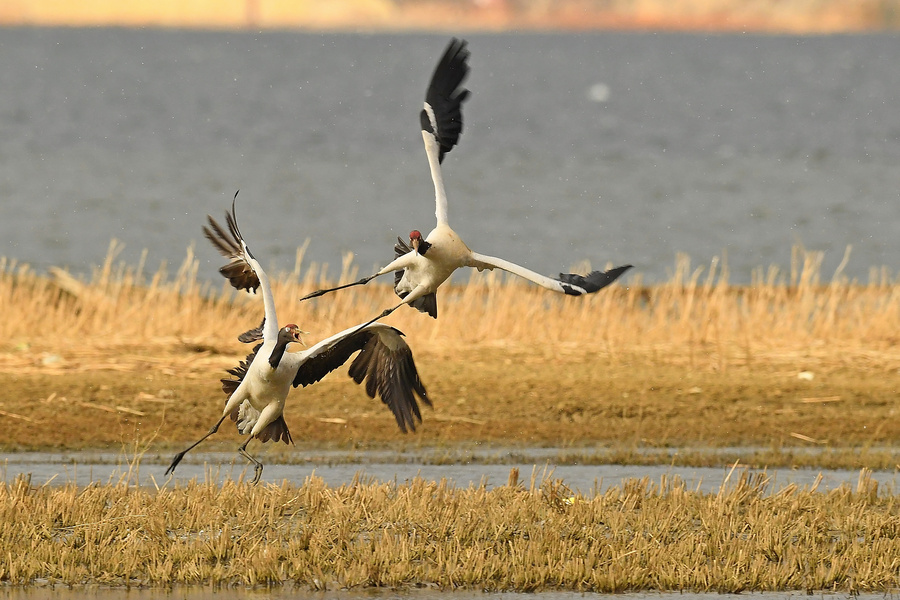A New Decade for Biological Diversity

After more than a year of marvelous journey, a herd of wild Asian elephants finally returned to their traditional habitat in southwestern China’s Yunnan Province on September 10, 2021. During the unusual trip, local authorities made robust efforts to track and steer the herd to avoid clashes between residents and the elephants, which resulted in a vivid lesson in biodiversity conservation.
The 15th meeting of the Conference of the Parties to the Convention on Biological Diversity (COP15) will be held in two phases from October 11 to 15 and the first half of 2022 in Kunming, capital of Yunnan Province. The decisions made therein by the international community and the Chinese government will promote global biodiversity governance, said Cui Shuhong, director general of the Department of Natural Ecological Protection under China’s Ministry of Ecology and Environment.

Black-necked cranes near Napa Lake in Shangri-La. The black-necked crane, the only alpine member of the crane species, is the most prominent flagship species of many wetlands in southwestern China’s Tibet Autonomous Region and the Himalayan region. by Wang Cheng
Exploration and Practice
Malania oleifera, called “garlic-fruit tree” by locals of southeastern Yunnan due to its garlic-shaped fruits, is an endemic plant that survived the Quaternary glaciation. The plant almost went extinct due to human activity because its seeds contain nervonic acid that can prevent Alzheimer’s disease. Yang Yuming, a professor at the Yunnan Academy of Forestry and Grassland, suggested rescuing the species through artificial means. Nearly two million trees have been planted over the last decade across 17 square kilometers. The species is no longer endangered and has generated income for local people. Such practices create ecological, economic, and social benefits. “The garlic-fruit tree conservation case demonstrates that every species has potential value and practical significance,” said Yang. “There are many other similar cases in Yunnan.”
Yunnan occupies only 4.1 percent of China’s land area but is home to half of the country’s species and hosts every type of ecosystem on Earth except for ocean and desert. It is a treasure trove of animals and plants. However, the diverse species in the province are characterized by small population and narrow distribution. Luckily, in recent years, Yunnan has stepped up efforts to protect the habitats of rare and endangered species and mobilized communities near nature reserves to manage and conserve biodiversity. It has set solid standards for protecting and restoring rare and endangered species throughout the country.
The polulations of about 50 species of wild animals in Yunnan have increased in recent years. As many as 420 species of birds migrate to Yunnan every year. The numbers of rare and endangered species such as the Asian elephant, the Yunnan snub-nosed monkey, and the green peafowl have been steadily increasing. The population of Asian elephants has doubled from 150 to about 300, according to Wang Tianxi, deputy director of the province’s Department of Ecology and Environment.

The first phase of COP15 will be held from October 11 to 15 at the Dianchi International Convention and Exhibition Center in Kunming. Xinhua
Opportunities for Transformation
Eleven years ago, the Aichi Targets for biodiversity protection were set. However, none of the 20 targets were met in full, according to the 5th edition of Global Biodiversity Outlook, published in 2020. Studies showed that global biodiversity continues to decline at an alarming rate, and scientists have called to protect at least 30 percent of the planet’s surface by 2030 to avert global catastrophic biological risks.
Human beings are poised at a crossroads of protecting biodiversity and realizing global sustainability, and COP15 is arriving at the right time. Cui Shuhong said that COP15 will review progress and experience gained in fulfilling global biodiversity goals over the past decade and design a Post-2020 Global Biodiversity Framework featuring opportunities for transformation of biodiversity conservation and reversal of the deterioration of global biodiversity.
Protecting biodiversity requires far more than documents from international conferences or nature reserves established deep in the mountains. It is relevant to every human’s daily life. Public participation in biodiversity protection means a lot. In recent years, wild raccoon dogs have been found in some communities in Shanghai. The local residents were afraid and perceived them as a threat at first but they gradually learned to coexist with the wild animal thanks to science popularization activities on urban wildlife led by a local research team. All they needed was to know more about the species. In an ecologically harmonious city, residents coexist with animals and plants.
To honor COP15, various activities related to science popularization have been organized across China, providing wonderful platforms for nature lovers to participate in biodiversity conservation. Cui hopes the public will seize the moment of COP15 to join the biodiversity conservation movement.